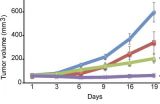(Press-News.org) DURHAM, N.H. – For more than 40 years, policy makers have been working to reduce acid rain, a serious environmental problem that can devastate lakes, streams, and forests and the plants and animals that live in these ecosystems. Now new research funded by the NH Agricultural Experiment Station (NHAES) at the University of New Hampshire College of Life Sciences and Agriculture indicates that lakes in New England and the Adirondack Mountains are recovering rapidly from the effects of acid rain.
Researchers found that sulfate concentration in rain and snow declined by more than 40 percent in the 2000s, and sulfate concentration in lakes declined at a greater rate from 2002 to 2010 than during the 1980s or 1990s. During the 2000s, nitrate concentration in rain and snow declined by more than 50 percent and nitrate concentration declined in lakes.
"This is really good news for New England. Lakes are accelerating in their recovery from the past effects of acid rain. Our data clearly demonstrate that cleaning up air pollution continues to have the desired effect of improving water quality for our region's lakes," said NHAES researcher William McDowell, professor of environmental science and director of the NH Water Resources Research Center.
In addition to McDowell, the research team included Kristin Strock, assistant professor at Dickinson College; Sarah Nelson, assistant research professor with the Senator George J. Mitchell Center and cooperating assistant research professor in Watershed Biogeochemistry in the UMaine School of Forest Resources; Jasmine Saros, associate director of the Climate Change Institute at UMaine and professor in UMaine's School of Biology & Ecology; Jeffrey Kahl, then-director of environmental and energy strategies at James Sewall Company.
Researchers analyzed data collected since 1991 at 31 sites in Maine, New Hampshire, Vermont, Massachusetts, Rhode Island, and southern New York and 43 sites in the Adirondack Mountains of New York. The results are presented in "Decadal Trends Reveal Recent Acceleration in the Rate of Recovery from Acidification in the Northeastern U.S." in the journal Environmental Science & Technology.
According to the U.S. EPA, acid rain refers to a mix of wet and dry materials from the atmosphere containing higher-than-normal amounts of nitric and sulfuric acids. The precursors of acid rain formation result from both natural sources, such as volcanoes and decaying vegetation, and man-made sources, primarily emissions of sulfur dioxide and nitrogen oxide resulting from fossil fuel combustion.
In the United States, roughly two-thirds of all sulfur dioxide and a quarter of all nitrogen oxide come from electric power generation that relies on burning fossil fuels, such as coal. Acid rain occurs when these gases react in the atmosphere with water, oxygen, and other chemicals to form various acidic compounds. The result is a mild solution of sulfuric acid and nitric acid. When sulfur dioxide and nitrogen oxides are released from power plants and other sources, prevailing winds blow these compounds across state and national borders, sometimes over hundreds of miles.
Enacted in 1970, the U.S. Clean Air Act was amended in 1990 and implemented in 1994 to regulate emissions, especially from coal-burning power plants. The Clean Air Interstate Rule issued in 2005 by the EPA sought to further reduce sulfur dioxide and nitrogen oxides by 70 percent. Following these policy changes, total emissions of sulfur and nitrogen in the United States decreased by 51 and 43 percent, respectively, between 2000 and 2010, which was twice the rate of decline for both in the 1990s.
INFORMATION:
Founded in 1887, the NH Agricultural Experiment Station at the UNH College of Life Sciences and Agriculture is UNH's original research center and an elemental component of New Hampshire's land-grant university heritage and mission. We steward federal and state funding to provide unbiased and objective research concerning diverse aspects of sustainable agriculture, aquaculture, forest management, and related wildlife and natural resources. We maintain the Woodman and Kingman agronomy and horticultural farms, the Macfarlane Greenhouses, the Fairchild Dairy Teaching and Research Center, and the Organic Dairy Research Farm. Additional properties also provide forage, forests and woodlands in direct support to research, teaching, and outreach.
The University of New Hampshire, founded in 1866, is a world-class public research university with the feel of a New England liberal arts college. A land, sea, and space-grant university, UNH is the state's flagship public institution, enrolling 12,300 undergraduate and 2,200 graduate students.
NHAES research: New England lakes recovering rapidly from acid rain
2014-06-09
ELSE PRESS RELEASES FROM THIS DATE:
Angry faces back up verbal threats, making them seem more credible
2014-06-09
We've all been on the receiving end of an angry glare, whether from a teacher, parent, boss, or significant other. These angry expressions seem to boost the effectiveness of threats without actual aggression, according to research published in Psychological Science, a journal of the Association for Psychological Science.
The research findings show that angry expressions lend additional weight to a negotiator's threat to walk away from the table if his or her demands aren't met, leading the other party in the negotiation to offer more money than they otherwise would have.
"Our ...
Distance from a conflict may promote wiser reasoning
2014-06-09
If you're faced with a troubling personal dilemma, such as a cheating spouse, you may think about it more wisely if you consider it as an outside observer would, according to research forthcoming in Psychological Science, a journal of the Association for Psychological Science.
"These results are the first to demonstrate a new type of bias within ourselves when it comes to wise reasoning about an interpersonal relationship dilemma," says psychology researcher and study author Igor Grossmann of the University of Waterloo in Canada. "We call the bias Solomon's Paradox, ...
Penn Medicine at the International Congress of Parkinson's Disease and Movement Disorders
2014-06-09
Penn Medicine researchers will be among the featured presenters at the 18th International Congress of Parkinson's Disease and Movement Disorders in Stockholm, Sweden, from Sunday, June 8 to Thursday, June 12, 2014.
Matthew Stern, MD, director of the Parkinson's Disease and Movement Disorders Center in the Department of Neurology and current president of the International Parkinson's Disease and Movement Disorders Society, will chair a plenary session entitled "New insights into the pathology, progression, and heterogeneity of Parkinson's disease."
John Q. Trojanowski, ...
What causes garlic breath? (video)
2014-06-09
WASHINGTON, June 9, 2014 — Garlic is good for your body, great for your taste buds, but terrible for your breath. In the American Chemical Society's latest Reactions video, we look at the plant beloved by chefs and feared by vampires. Once again we teamed up with the Compound Interest blog to break down the chemistry of garlic, and how to beat the bad breath it causes. The video is available at http://youtu.be/cAWLQ_4DphI.
INFORMATION:
Subscribe to the series at Reactions YouTube, and follow us on Twitter @ACSreactions to be the first to see our latest videos.
The ...
Health Affairs asks: Where can we find savings in health care?
2014-06-09
Reducing Maternal Mortality In Zambia and Uganda. Margaret E. Kruk of Columbia University and co-authors assessed the effectiveness of Saving Mothers, Giving Life, a new global public-private partnership that aims to reduce maternal mortality in eight districts in Uganda and Zambia. They evaluated the first six to twelve months of the program's implementation, its ownership by national ministries of health, and its effects on health systems. According to the authors, early benefits to the broader health system included greater policy attention to maternal and child health, ...
Common bean genome sequence provides powerful tools to improve critical food crop
2014-06-09
Huntsville, Ala. – String bean, snap bean, haricot bean, and pinto and navy bean. These are just a few members of the common bean family — scientifically called Phaseolus vulgaris. These beans are critically important to the global food supply. They provide up to 15 percent of calories and 36 percent of daily protein for parts of Africa and the Americas and serve as a daily staple for hundreds of millions of people.
Now, an international collaboration of researchers, led by Jeremy Schmutz of the HudsonAlpha Institute for Biotechnology and Phillip McClean, of North Dakota ...
Sequencing of citrus genomes points to need for more genetic diversity to fight disease
2014-06-09
Huntsville, Ala. – Sequencing the genomes of domesticated citrus revealed a very limited genetic diversity that could threaten the crop's survival prospects, according to an international research team. In a study published in the June issue of Nature Biotechnology, the international consortium of researchers from the United States, France, Italy, Spain and Brazil analyzed and compared the genome sequences of 10 diverse citrus varieties, including sweet and sour orange along with several important mandarin and pummelo cultivars. The findings provide the clearest insight ...
Combination therapy may help patients with follicular lymphoma
2014-06-09
A new study in The Journal of Experimental Medicine reveals that a high-risk group of patients with follicular lymphoma could benefit from a novel drug combination.
Follicular lymphoma, a B cell lymphoma, is an incurable form of non-Hodgkin lymphoma that is diagnosed each year in 120,000 people worldwide. Follicular lymphoma is characterized by slow and relentless tumor growth with inevitable relapses despite intense chemotherapy. Follicular lymphomas are driven by mutations that activate the BCL2 protein, which prevents cancer cells from dying, but additional genetic ...
No limits to human effects on clouds
2014-06-09
Understanding how clouds affect the climate has been a difficult proposition. What controls the makeup of the low clouds that cool the atmosphere or the high ones that trap heat underneath? How does human activity change patterns of cloud formation? The research of the Weizmann Institute's Prof. Ilan Koren suggests we may be nudging cloud formation in the direction of added area and height. He and his team have analyzed a unique type of cloud formation; their findings, which appeared recently in Science indicate that in pre-industrial times, there was less cloud cover over ...
UNC researchers pinpoint new role for enzyme in DNA repair, kidney cancer
2014-06-09
CHAPEL HILL, N.C. – Twelve years ago, UNC School of Medicine researcher Brian Strahl, PhD, found that a protein called Set2 plays a role in how yeast genes are expressed – specifically how DNA gets transcribed into messenger RNA. Now his lab has found that Set2 is also a major player in DNA repair, a complicated and crucial process that can lead to the development of cancer cells if the repair goes wrong.
"We found that if Set2 is mutated, DNA repair does not properly occur" said Strahl, a professor of biochemistry and biophysics. "One consequence could be that if you ...



